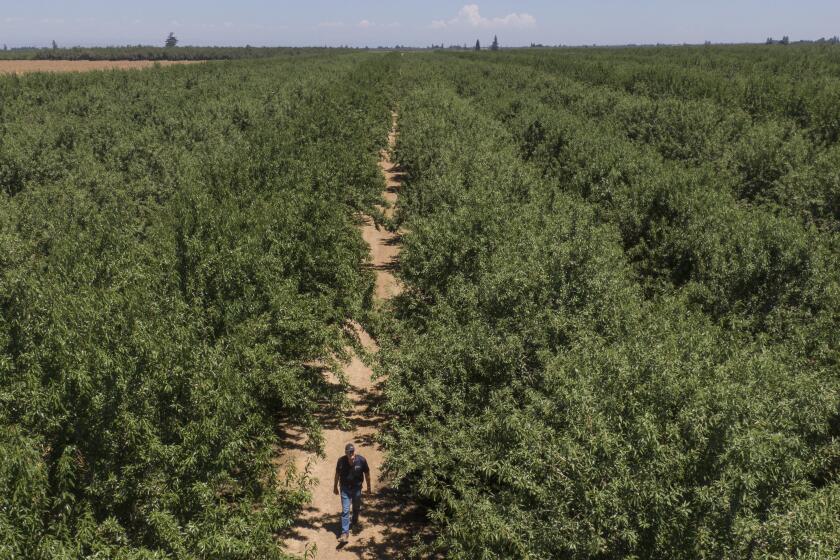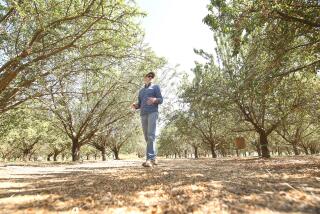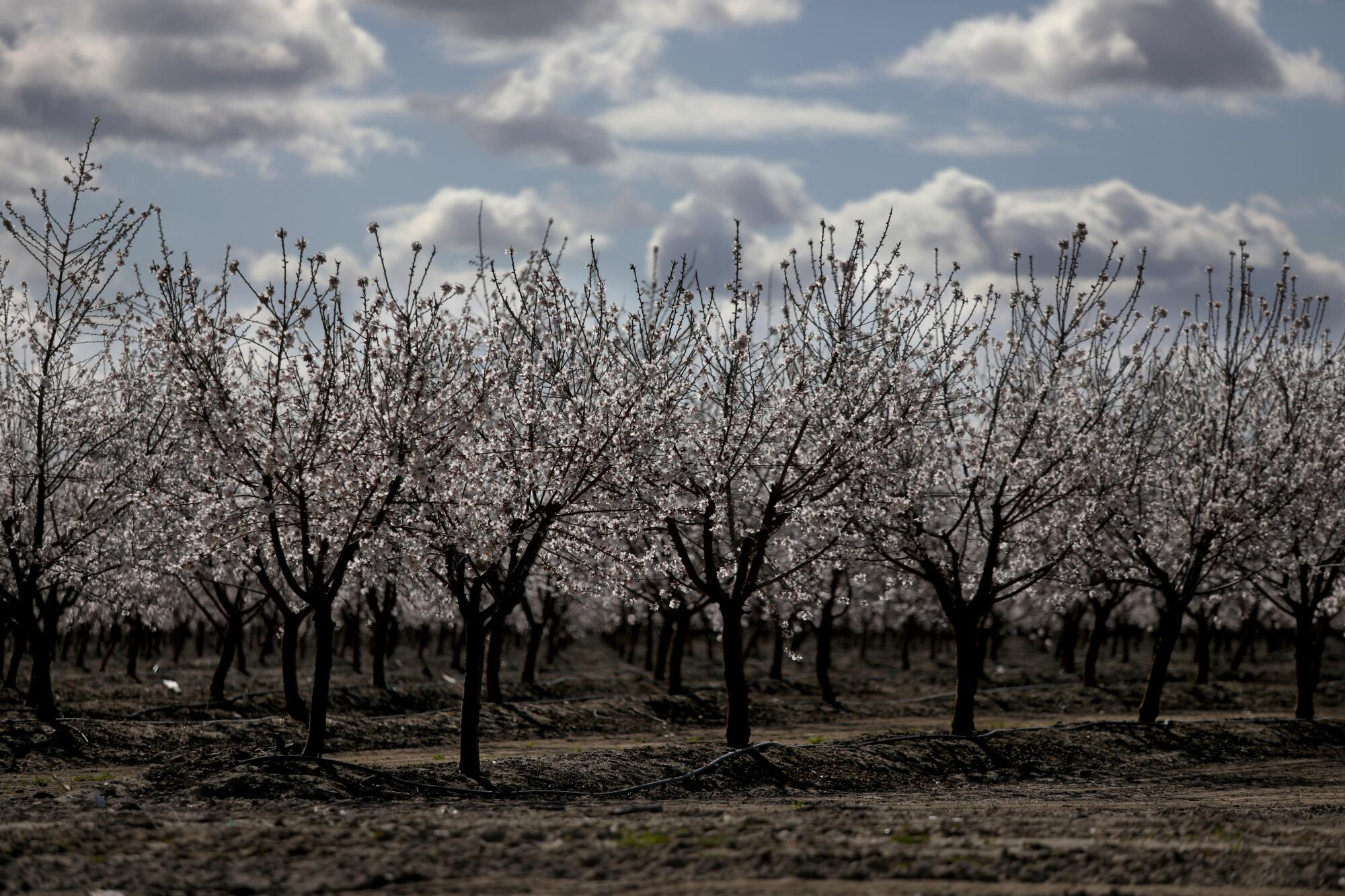
- Share via
For much of the last decade, almonds have been such a lucrative crop that growers and investment firms have poured money into planting new orchards across vast stretches of California farmland.
Now, the almond boom has fizzled and the industry has entered a slump. Prices have dropped over the last several years, and the state’s total almond acreage has started to decrease as growers have begun to tear out orchards and plant other crops.
Aggressive and impactful reporting on climate change, the environment, health and science.
In a sign of the troubles besetting the industry, one large almond-growing conglomerate has declared bankruptcy.
In a series of Chapter 11 filings in federal bankruptcy court, Trinitas Farming and other affiliated companies said that record-low almond prices and high interest rates contributed to their “serious liquidity constraints.”
The group of companies said in a court document filed Feb. 19 that they own 7,856 acres of almond orchards in five counties, including Solano, Contra Costa, San Joaquin, Fresno and Tulare. As part of the bankruptcy proceedings, these orchards are expected to be put up for sale.
“When the price is low, now we start seeing the results of it. And certainly the fear is that Trinitas is the tip of the iceberg,” said Jake Wenger, general manager of the Salida Hulling Assn., which runs an almond-hulling plant in Modesto.
As almond growers use increasingly scarce and expensive water to irrigate this year’s crop, over a billion pounds of nuts remain stranded in port.
Prices for premium almonds have dropped from nearly $4 a pound a decade ago to about $2 a pound or less, Wenger said. Though the low prices are affecting all growers, those that are being hit especially hard are the many investor groups that bought land when prices were high and now have large debts, he said.
“The question becomes, do some of these banks call on some of these loans? And that’s really going to be a concern for a lot of people in the industry,” Wenger said. “Nobody got more indebted to the banks than a lot of these investor groups.”
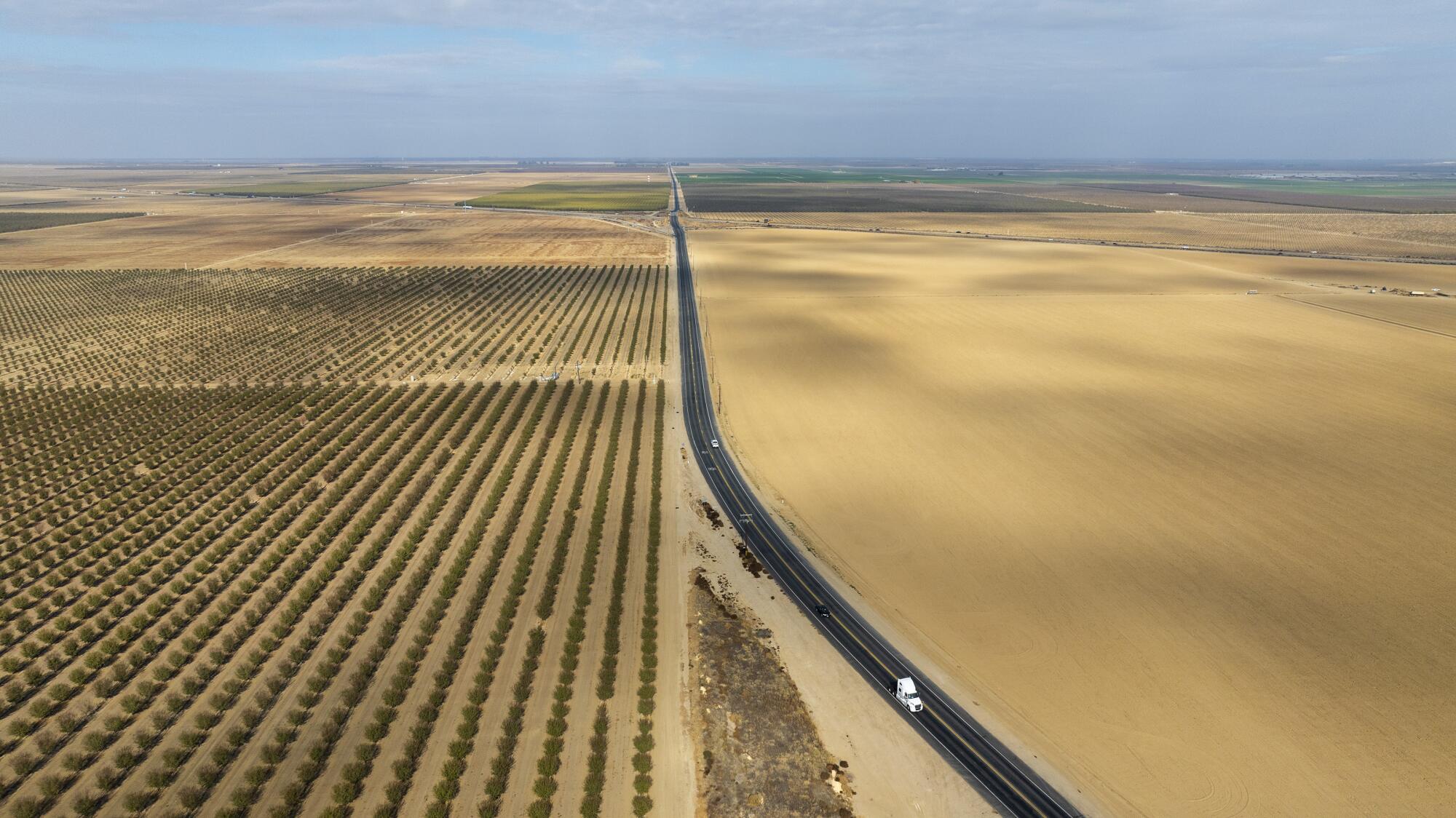
The group that filed for bankruptcy includes Trinitas Advantaged Agriculture Partners IV, LP, an investment fund that was formed and managed by Redwood City-based Trinitas Partners, a private equity investment company. It also includes the investment fund’s subsidiary Trinitas Farming, based in Oakdale, and 17 other subsidiaries.
The group’s lawyers said in court documents that the investment fund was organized by Trinitas Partners in 2015 to develop and operate almond farms in the Central Valley. It said the companies were ”well-positioned to become profitable ventures” but that they were ultimately “unable to raise necessary capital” through investments or from potential sales of assets. The entities’ reported debts total approximately $180 million.
Trinitas Partners itself was not among the companies that filed for bankruptcy. Representatives of the companies did not respond to requests for comments about the matter.
“I really firmly believe they’re not going to be the only ones facing financial struggles,” Wenger said.
The low prices appear to be making it difficult for some investments to pencil out. Wenger and others in the almond business have noticed some orchards abandoned in parts of the Central Valley over the last year, with rows of unkempt trees now filled with weeds.
“We’re already seeing people walk away,” Wenger said.
He said he believes almond prices will eventually rebound, but it’s not clear when that turnaround might come.
“I certainly don’t think we’ve seen the worst of it yet,” Wenger said.
While various factors have contributed to the situation, Wenger and others say some of the issues weighing on prices include an oversupply of almonds after years of rapid growth.
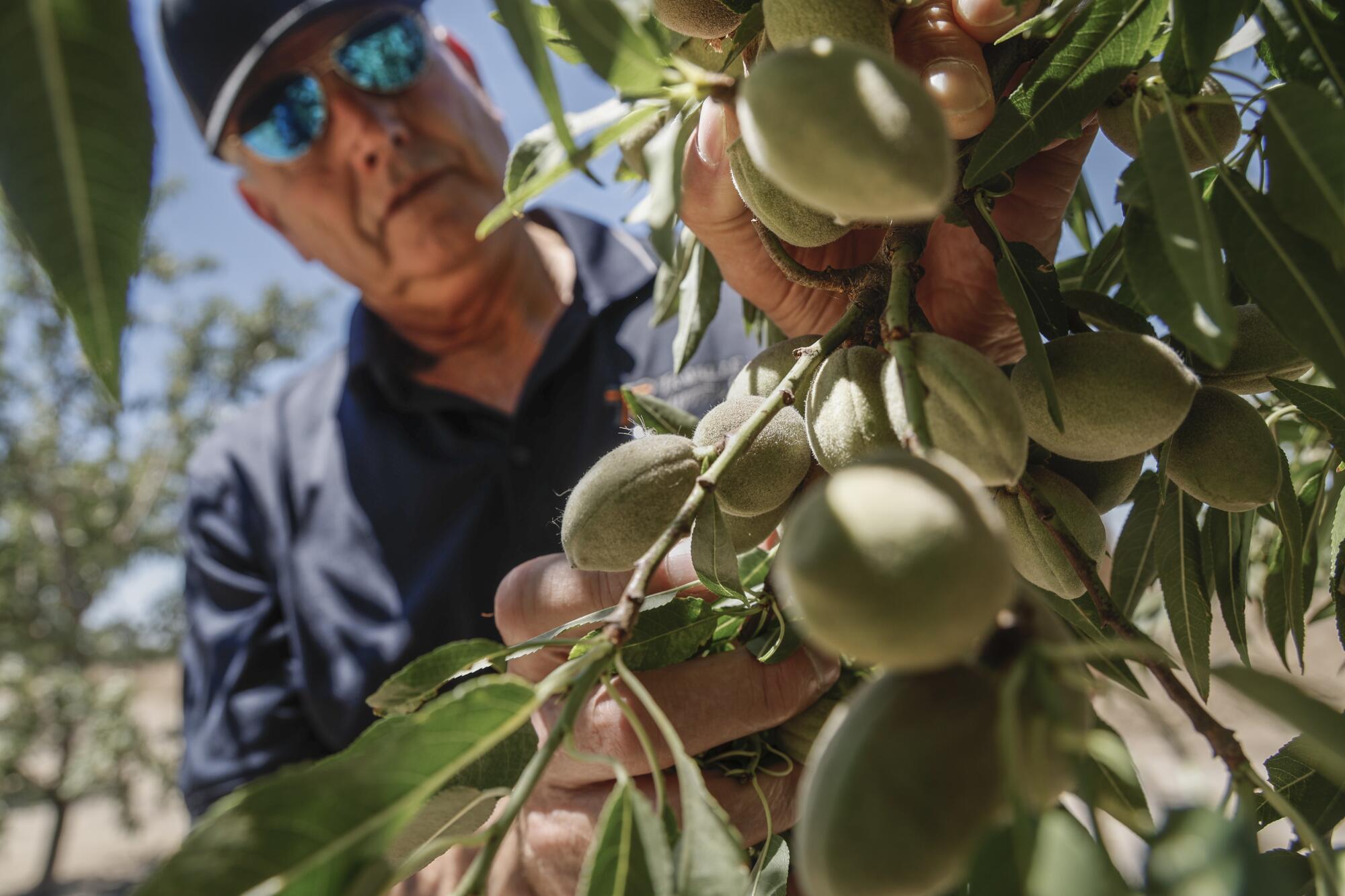
California produces about 80% of the world’s supply of almonds. And according to federal data, the state’s harvested almond orchards skyrocketed from 760,000 acres in 2011 to more than 1.3 million acres in 2022.
In the last two years, though, annual mapping of orchards has shown that California’s total almond acreage has started to decline.
Over the last decade, the almond boom coincided with growing concerns about water in California. When growers and investment companies bought land and drilled wells to pump groundwater in the Central Valley, the expanding nut orchards locked in long-term water demands and added to the strains on the state’s declining aquifers.
Wenger said he thinks it’s possible that if some of these orchards come out of production, groundwater levels could rise in places.
“It depends on what cropping patterns come in, and what happens next,” he said. “But it does have a potential that we could see benefits to groundwater.”
Critics who have questioned the amount of water dedicated to growing almonds include Bill Maher, who recently drew laughs on his show when he urged Gov. Gavin Newsom to “take on Big Almond.”
The environmental group Food and Water Watch has also urged the state to limit the expansion of almond orchards and other water-intensive crops such as alfalfa. Chirag Bhakta, the group’s California director, said the expansion of almonds has “locked us into a situation where we’re growing way too many of these thirsty tree nuts in parts of California,” adding to the problems of overpumping of groundwater.
Bhakta said it’s hard to know if the bankruptcy case points to more trouble ahead in the industry. But he said it represents an “opportunity for us to shift what’s been grown on that land to actually reflect what’s best for California” and the state’s water needs.
Amid drought, environmental advocates are calling on Gov. Gavin Newsom to stop the expansion of the agriculture and fossil fuel industries.
Representatives of the almond industry have defended the crop’s water use, pointing to agricultural statistics showing almonds cover 21% of irrigated agricultural land in California but account for 14% of agricultural water use. They have also noted that in addition to the nuts, almond hulls are used for cattle feed.
In the coming years, California’s agriculture industry will face water limits under the requirements of the state’s 2014 Sustainable Groundwater Management Act. The law requires local agencies in many areas to develop plans to curb overpumping by 2040.
Researchers with the Public Policy Institute of California have estimated that addressing the groundwater deficit in the San Joaquin Valley will probably require taking at least half a million acres of farmland out of production, and they’ve called for expanding efforts to help convert farmland to other uses, such as solar development or habitat areas.
Aside from water constraints, the almond industry has faced other challenges, including tariffs in China and other countries, as well as shipping bottlenecks during the COVID-19 pandemic.
“There has just been a glut in the almond market for a couple of years now,” said Caity Peterson, associate director of the Public Policy Institute of California’s Water Policy Center.
“It’s possible that we have hit peak almond,” Peterson said. “The industry will probably right-size itself to where the supply better meets the demand and it’s not oversupply, like we’ve got right now.”
Some experts say the almond industry is likely to bounce back. Analysts with Rabobank wrote in an analysis this month that “a strong rebound in almond prices is expected over the next 12 to 18 months.”
California groundwater levels have risen in many areas this year, but after years of over-pumping, aquifer levels largely remain lower than two decades ago.
International markets have a big influence. According to the most recent crop data for the 12 months that ended in July 2023, 72% of the state’s almonds were exported, while 28% were sold domestically.
California’s total almond acreage has gone down the last two years mostly because of decreases in new plantings, said Rick Kushman, a spokesperson for the Almond Board of California.
“Orchards last about 25 years, then growers replant, if they decide to. It’s possible that financing has been harder to get and it is surely more expensive right now,” Kushman said in an email. “Shipments have been strong in recent months, but we are a long way from seeing if that will affect planting decisions.”
There are roughly 7,600 almond farms in the state, and about 70% of the state’s orchards are under 100 acres, according to the Almond Board of California.
Wenger said those who are better suited to weather this sort of downturn are family-run businesses that own their land debt-free.
Almond growers aren’t the only ones in agriculture who have been dealing with tough economic conditions.
“Walnut prices are terrible. Grape prices are terrible,” Wenger said. “Pistachios are not doing great. So we have all these crops that are starting to suffer.”
The fall of the Trinitas almond business follows the recent news that the large fruit grower Prima Wawona also filed for bankruptcy.
Some growers in the San Joaquin Valley have chosen to replace almond trees with pistachio orchards.
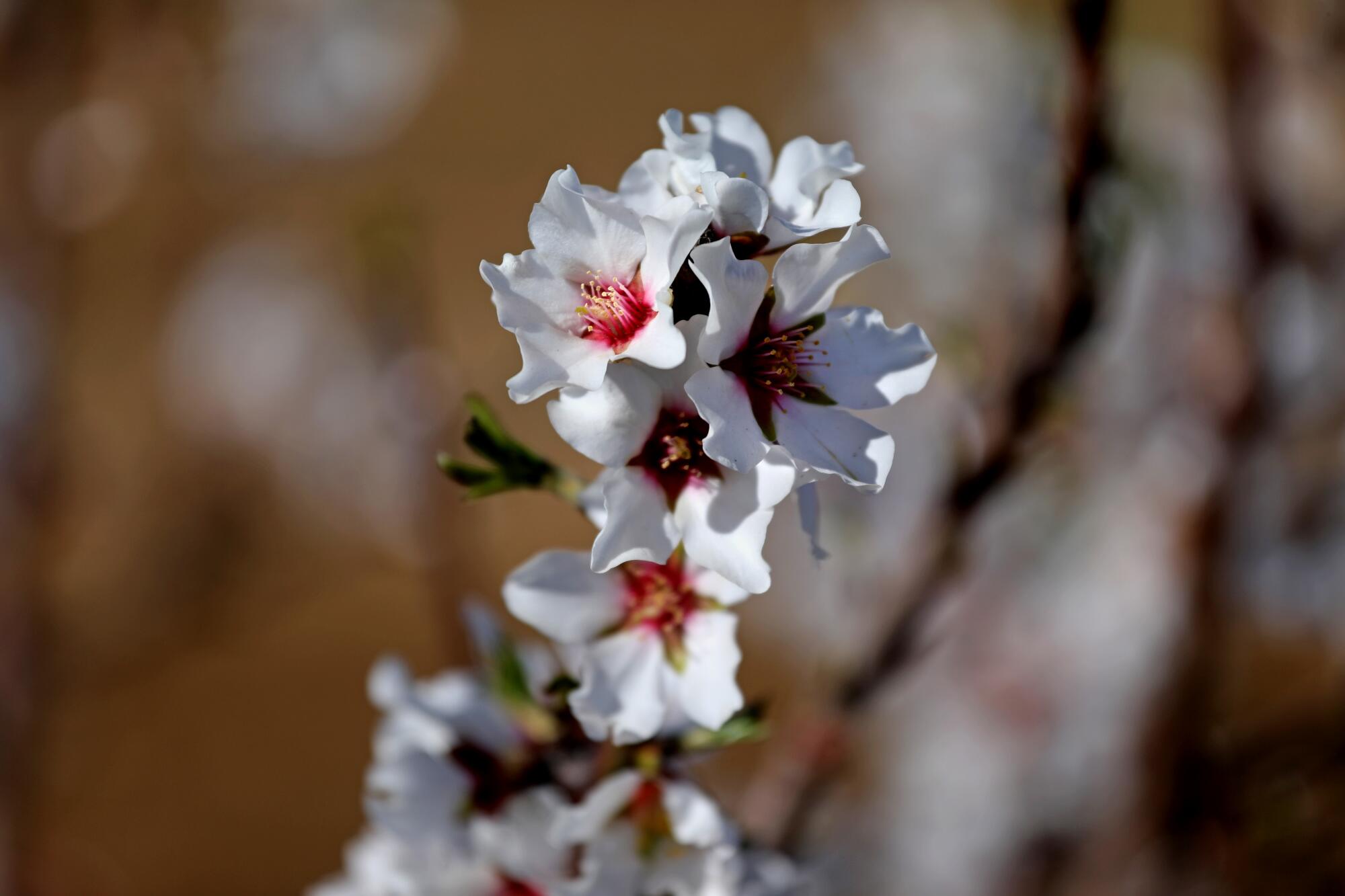
Still, most of California’s almond orchards remain, and almond trees have been blooming with white and pink flowers in the Central Valley.
“Agriculture in general is seeing some very difficult times,” said Bill Lyons, a farmer in Stanislaus County who once served as state agriculture secretary under Gov. Gray Davis.
On his family’s century-old ranch, they have a cattle operation and grow a wide variety of crops.
“We’ve been in the almond business for over 25 years, and we’re seeing unprecedented low prices for multiple years, and very high expenses,” Lyons said. “And when you combine the two, it’s extremely difficult for any almond farmer to make a profitable living.”
He said where some landowners have abandoned their trees, it’s a problem for neighboring growers because the untended orchards can harbor pests — such as navel orangeworm — that can spread to nearby orchards.
Lyons said his family plans to keep growing almonds.
“Hopefully, the almond price will gain momentum,” Lyons said. “I have confidence in the almond industry, but it’s definitely going to be a serious bump in the road as we travel through to next year or so.”
Times staff writer Kevin Rector contributed to this report.


